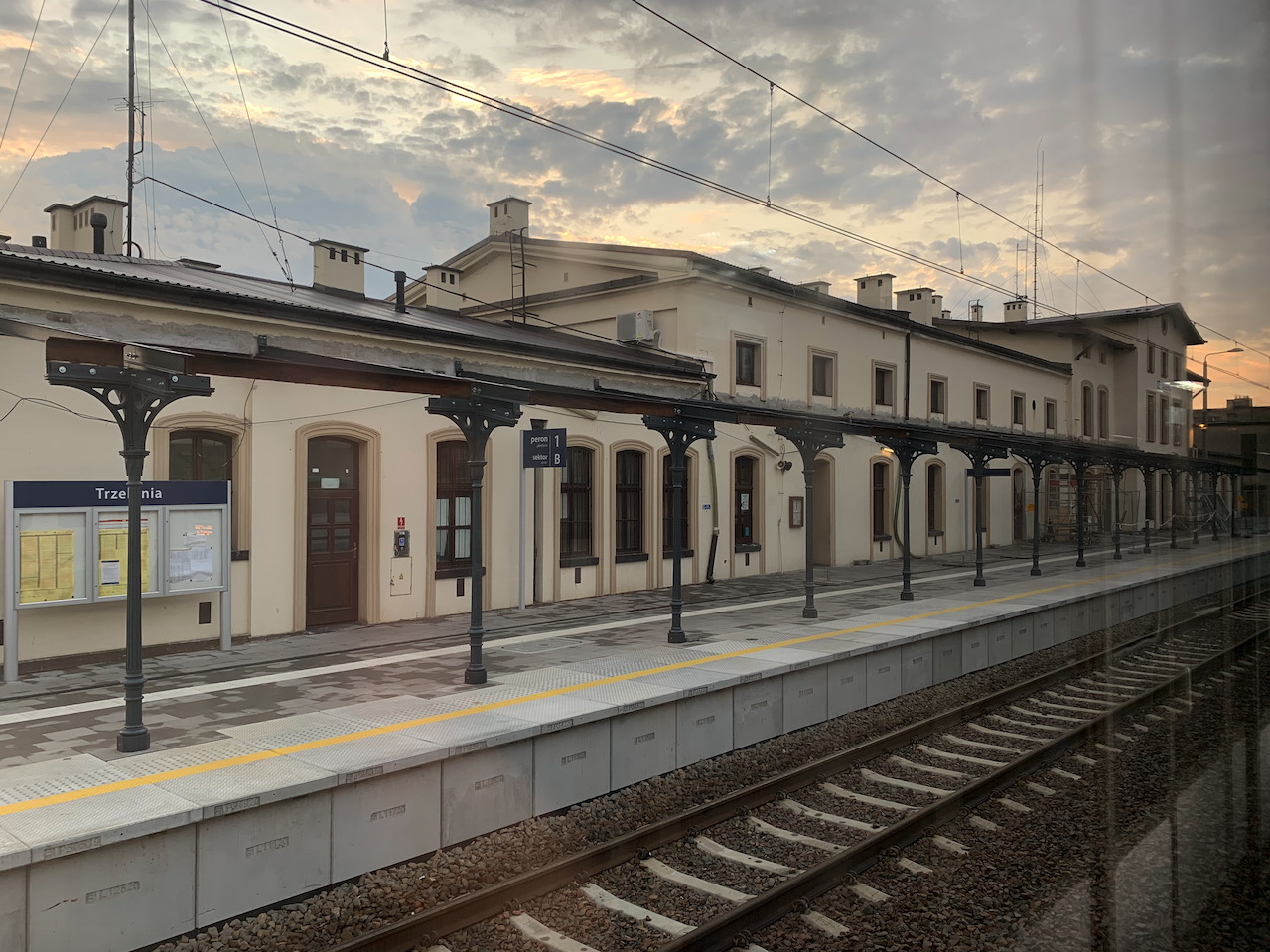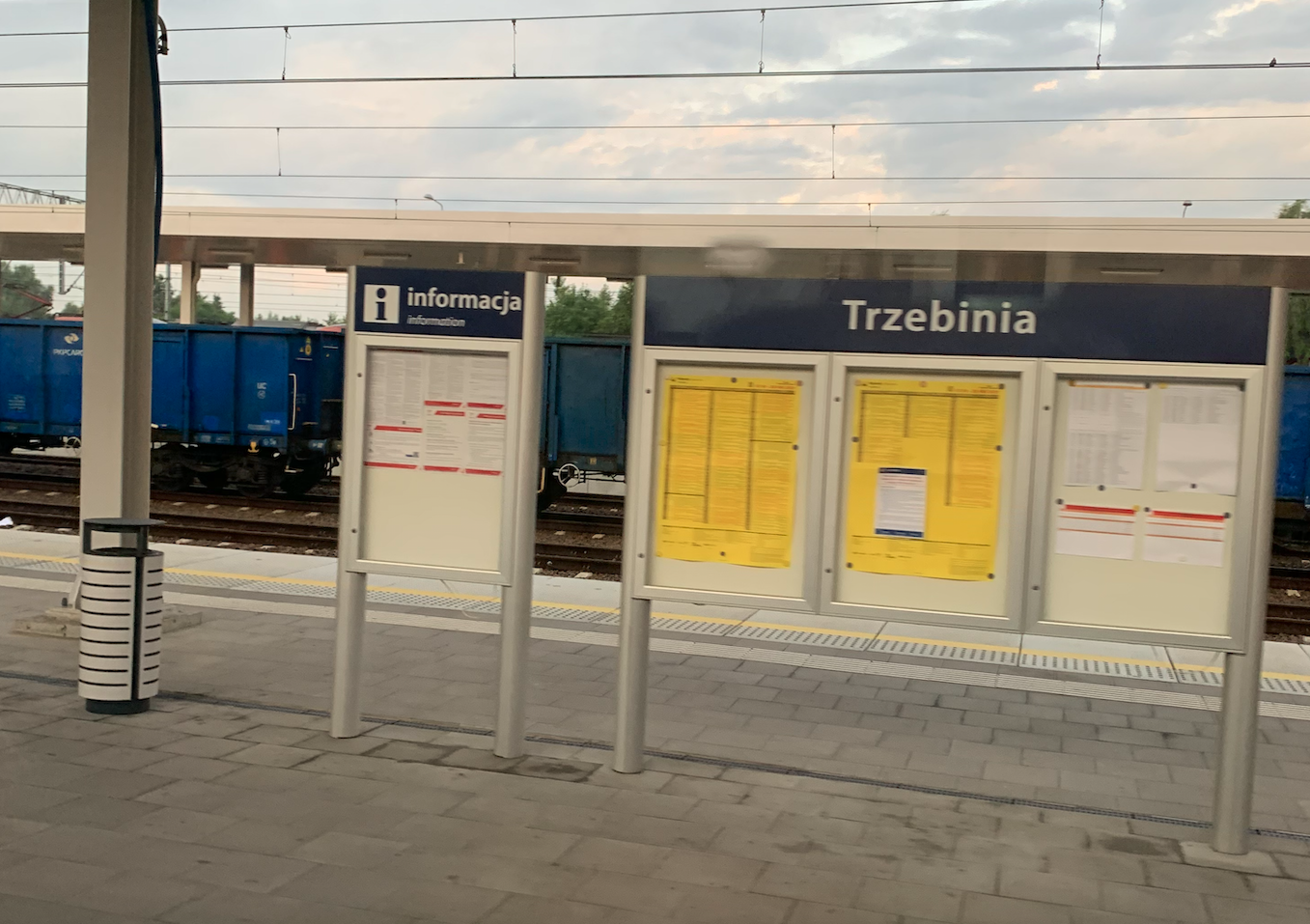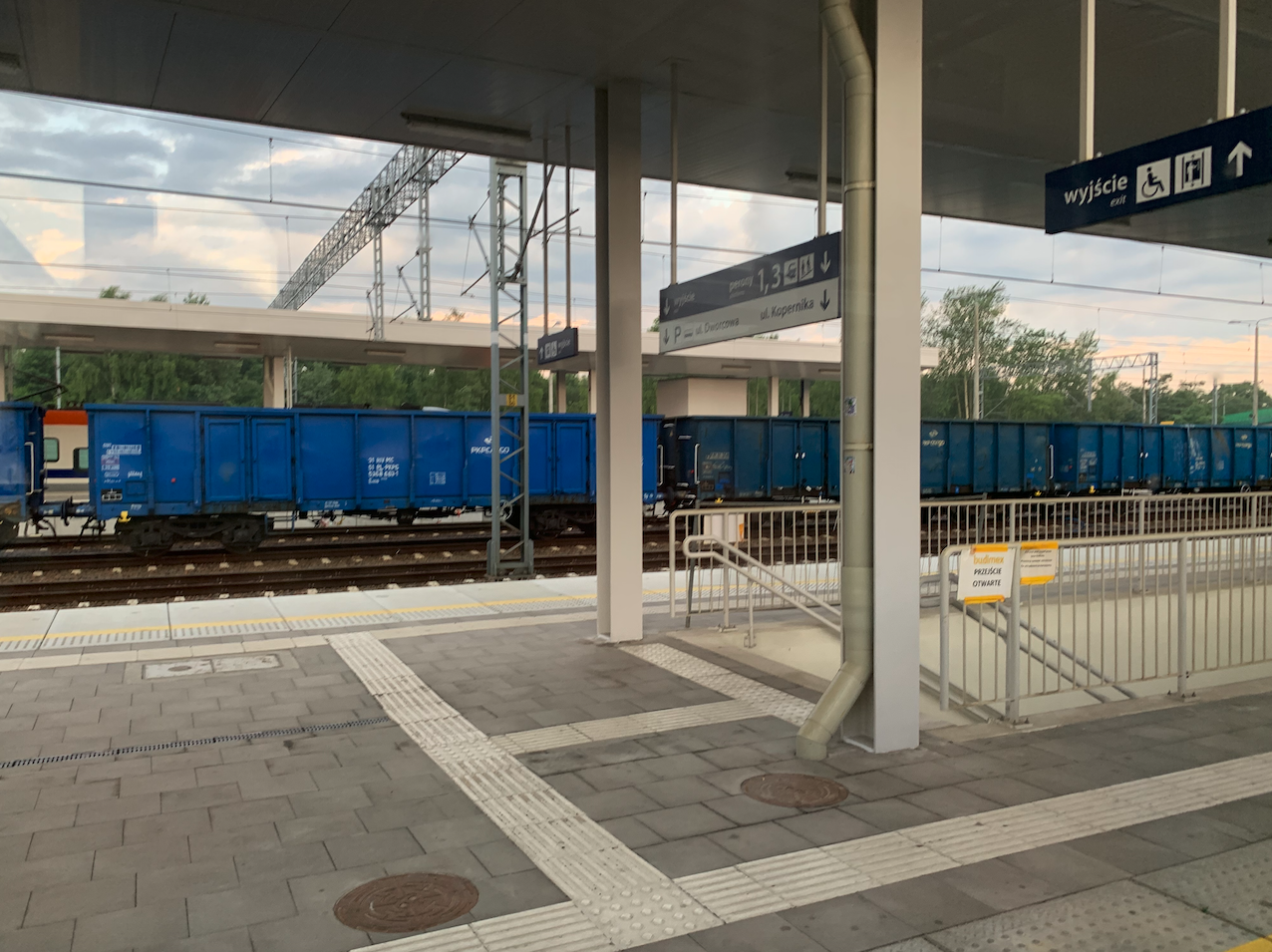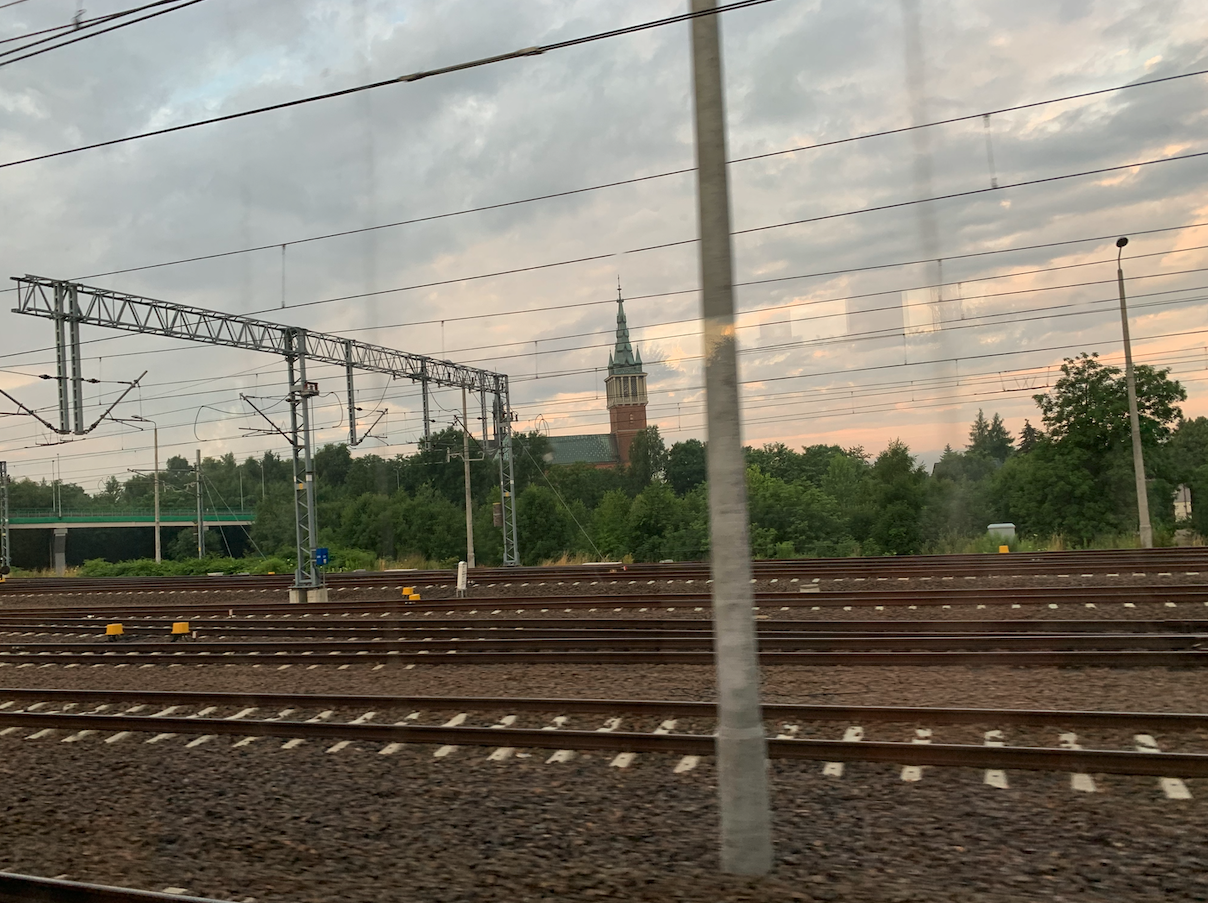Trzebinia 2022-01-08
Railway station in Trzebinia.
The railway station in Trzebinia was opened in October 1847, along with the commissioning of the Mysłowice - Kraków line. As a result, it was possible to cross the entire line from Kraków to Wrocław. The construction of the line was carried out by the Kraków-Górnośląskie Society. The line was routed in such a way that it would bypass the Kingdom of Poland, i.e. the Russian partition. Russia was not interested in the development of railways. Trzebinia was then in Galicia in the Austrian partition. The Mysłowice station was then in the Kingdom of Prussia (in the Prussian partition). Communication between the stations was provided by a telegraph and riding on the so-called scepter.





The station building was built in 1847 and still exists today. The building is three-story and has a partial basement. There were cash desks, a waiting room, a restaurant (then a buffet), a kiosk and a post office in the building. Garages for postal carriages were added to the eastern side of the station building. In the following years, the post office was expanded. The Polish Post Office exists at the station until now. On the first floor of the station building there was a kitchen, a canteen, offices and a night shelter for railway workers. The upper floor is intended for housing for railroad families. On the west side of the station building there were toilets with an external entrance open to the public, separately for men and women. Most of the station area was fenced with a concrete, openwork fence.
Entering the platforms and restaurants required a ticket or a platform, which was checked by a railway employee. Platform tickets existed until the 1960s and cost 2 zlotys. Platform 1, along the entire length of the buildings (from the post office to the toilets), was covered with a canopy supported on cast iron poles and this is the case until now. The travelers walked to the platforms along the designated path through the track. Wooden beams were laid between the rails, which formed a path. The station had a water tower, and at each platform there were water cranes for the irrigation of steam locomotives. The station was illuminated by carbide lanterns. The first control room was located in the place where the viaduct of the national road No. 79 (Kościuszko Street) is located today, on the northern side of the tracks. The viaduct over the tracks was built in 1975.
On November 18, 1918, Poland established the Railway Protection Guard (SOK), which also had a post at the station in Trzebinia. In the 1960s, the Railway Health Center was established in an existing building near the station.
After losing the defensive war in 1939, the Germans established the General Government in occupied Poland. It was a fictitious state, the aim of which was to liquidate or Germanize the remaining Poles and, as a last resort, incorporate the state into the German Empire. Trzebinia station became a border station between the German Empire and the General Government. During the German occupation, the nearby Trzebinia refinery was bombed several times by Allied planes. The Germans built air raid shelters in the station buildings in the basements.
In 1959, at the Trzebinia station, a footbridge was built over the tracks for travelers. The footbridge served not only travelers, but most of all the inhabitants of Trzebinia, for example the faithful who went to the holy masses at the Church of the Sacred Heart of Jesus, the Order of the Salvatorians. At the same time, the electrification of the Trzebinia railway junction began.
"Local" railway line.
When the Mysłowice - Kraków route was opened, various private companies began to connect to the route and lay more kilometers of tracks. One of the intermediate stations on the trail is Trzebinia. In a short time, Trzebinia became a junction station. In 1895, a private line from Trzebinia to Siersza was built. In 1899, a private line was established from Trzebinia to Alwernia and then through Trzebieńczyce and Wadowice to the Skawce station. The Siersza-Skawka line was private and had its own station in Trzebinia, at Dworcowa Street, next to the main station, about 200 meters away. During the German occupation, this station was called "Trzebinia Nord", and after World War II, "Trzebinia North". In 1945, the line Siercza - Skawce was nationalized and taken over by the Polish State Railways.
The Siercza - Skawce route did not connect with the Kraków - Mysłowice line, but it ran along the viaduct over the Kraków - Mysłowice tracks. In 1959, the Trzebinia station was expanded and additional tracks were built. As a result, the Trzebinia Północ railway station was closed. Both routes have been connected with each other. The railway viaduct was demolished. One of the reasons for the demolition of the viaduct was the electrification of the Trzebinia junction. The viaduct was located between the present Słowackiego Street and the Trzebinia locomotive shed. It was a steel truss running diagonally over the Mysłowice - Trzebinia - Kraków line.
Trzebinia Siersza station.
Trzebinia Siersza station is located only 5.48 km north of the Trzebinia station. Until 1996, it was used for passenger trains. Currently (2022), the Trzebinia Siersza station is a junction station and serves only freight traffic.
The station was established around 1910. At that time, it was called Siersza Wodna. At the time of its greatest development, the station had three earth platforms. Platform 3 was impassable and served trains in relation to Czechowice.
The station building is typically Austrian, two-storey. There were ticket offices and railway service rooms in the station building.
The Trzebinia Siersza railway junction was electrified in 1959.
Until 1996, trains (mainly EZT EN57 or SZT SA101) ran from the station via Alwernia, Spytkowice to Wadowice. The passengers were mainly miners of KWK Siersza and energy workers of the Siersza Power Plant. The mine was closed and the mining railroads were dismantled. The tracks to the power plant remained open.
Currently (2022), at the Trzebinia Siersza station, there is still a station building with a grocery store. The upper floor is occupied by housing for railway families. Directly at the station, there are four tracks, which in the northern part of the station converge into one track ended with a resistance trestle. Then the mine was closed. Two tracks were renovated in 2015. There are three more passages leading to the power plant in the vicinity, which combine to form a single track at a distance of 0.5 km from the station. The former railway line from this place ran to Jaworzno Szczakowa, which was dismantled.
Trzebinia station at present.
There are currently four routes at the Trzebinia station: No. 93 (initially No. 132, then No. 150) Trzebinia - Zebrzydowice, two-track electrified. No. 103 (initially No. 133, then No. 138) Trzebinia - Wadowice, single-track, electrified. No. 114 (initially No. 133, then No. 38) Trzebinia - Trzebinia Siersza, single-track, electrified, local importance. No. 133 (initially No. 131, then No. 100/140) Dąbrowa Górnicza Ząbkowice - Kraków Główny, is the main, double-track, electrified line, which is part of the European route E 30.
In 2017, the Trzebinia station served approximately 800 passengers a day. Passenger trains of the following carriers stopped at the station: InterCity, TLK, PolRegio. From March 2019, a train from the Czech carrier Leo Express, from Praha Hlavni Nadrazi - Kraków Główny, stopped at the station.
At the Trzebinia station, there is a depot, which currently (2022) is the TABOR Dębica Branch plant.
To the west of the Trzebinia station is a freight station, which also handles trains received and dispatched by Rafineria Trzebinia and other nearby factories. The freight station has 26 tracks, including 2 through tracks for passenger trains. At the western head of the goods station there is a control room with Tz1, and in the eastern head there is a TSB control room.Modernizacja stacji Trzebinia i szlaku E 30.
Modernization of the E 30 route on the section Jaworzno Szczakowa - Kraków Główny Towarowy was already necessary in the 90s of the 20th century. In November and December 2010, four contracts were signed for the modernization of the line No. 133 on the section Jaworzno Szczakowa - Kraków Główny Towarowy and on the line No. 134 on the section Sosnowiec Jęzor - Jaworzno Szczakowa. The cost of the renovation was estimated at PLN 1.3 billion. The works were scheduled to be completed in 2014. The works started, but the financial problems of the investor, i.e. the state, caused the contractors to go bankrupt. Work has been suspended. Further tenders for the performance of works have been announced. In 2014, only 2% of the planned investments were made. Even some project documentation was not ready. Only at the beginning of 2016, new contracts were concluded with new contractors. At the end of 2016, the works were well advanced.
Works at the Trzebinia station started in February 2017. The scope of work was very large. The main track work started in June 2017. As a result of the renovation, the route on the section Kraków - Jaworzno Szczakowa is approved for passenger traffic at a speed of 160 km / h. On August 30, 2021, the Trzebinia station was officially opened again by the Minister of Infrastructure Andrzej Adamczyk.
Now, at the station, travelers and residents alike use the tunnel under the tracks and platforms. Elevators have been installed for the disabled. The tunnel was made available to travelers in December 2020, although the finishing works were not yet completed. The reason was the dismantling of the existing footbridge. The inhabitants of Trzebinia counted on the construction of stairs from the viaduct of the national road No. 79. According to PKP PLK, the lack of access to the platforms from the viaduct was due to the fact that during the consultations no need to construct them was reported. The entire project was consulted with the local government of the City of Trzebinia, as well as with the owner of the viaduct. The fact is that the tunnel serves travelers and residents in a more comfortable way than the existing footbridge, which had no facilities for disabled travelers.
The inhabitants of Trzebinia are already benefiting from the effects of the line modernization. Thanks to the PKP PLK investment, the journey from Trzebinia to Katowice and Krakow takes about 30 - 35 minutes. Access to Krzeszowice or Jaworzno only 10 minutes.
The railway investment on the Kraków - Katowice section increased the level of safety thanks to 10 new collision-free intersections and modern control devices. Train traffic is carried out from the new local control centers. Computer systems support railwaymen in efficient and safe traffic management.
The train station building in Trzebinia was taken over by the City of Trzebinia. It is the local government that decides about the functions of the building, although the contract also mentions functions that are also used by travelers.
Platforms.
After modernization, the platforms have a different layout than before. Previously, there were also three platforms, but they had as many as 7 edges. Platform 3 had an unusual layout. In addition to the two through tracks, there was an additional two crossing tracks, terminated with switches. So Platform 3 had four edges. The 3-island platform was 475 m long. The footbridge over the platform fell out in the middle of its length. In theory, four trains could depart from this platform at the same time. It was true, however, that the eastern part of the platform was practically unused. There was no roof and no benches. The 2-island platform was 330 m long. The single-edged platform 1 was 300 m long. Between Platforms 2 and 1 there were additional three passageways for freight trains. Another three freight and holding tracks were on the south side of the station. In total, there were 12 tracks at the station.
The new platforms have a classic layout and are high platforms. Platform 1, 300 m long, next to the station. Platforms 2 and 3 are island platforms with a length of 310 m. There are currently two tracks for freight trains between Platforms 2 and 3. The new platforms are made of prefabricated elements in modern technology. The surface is non-slip and equipped with paths for the blind and yellow warning lines. All platforms are covered. Platform 1 has a historic roof supported by cast iron poles. There are benches, resting places, litter bins on the platforms, display cases with railway information, lighting and sound system.
Written by Karol Placha Hetman
